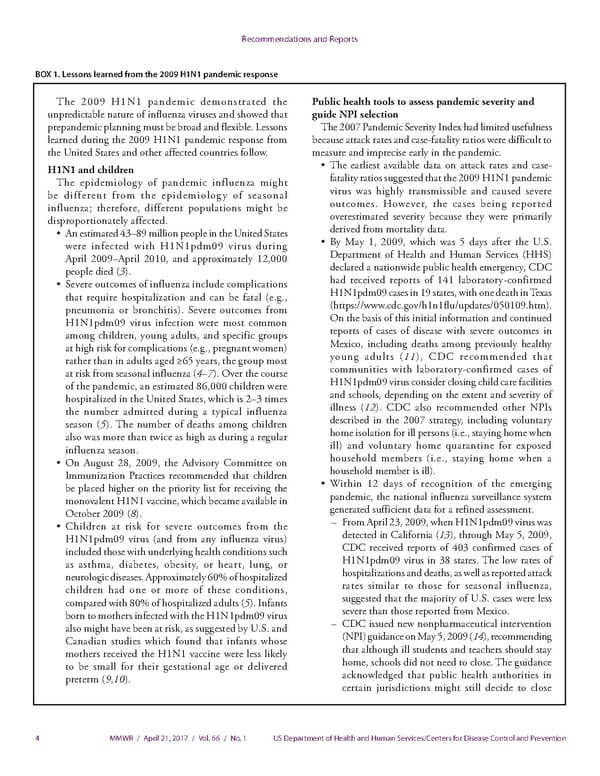Recommendations and Reports BOX 1. Lessons learned from the 2009 H1N1 pandemic response The 2009 H1N1 pandemic demonstrated the Public health tools to assess pandemic severity and unpredictable nature of influenza viruses and showed that guide NPI selection prepandemic planning must be broad and flexible. Lessons The 2007 Pandemic Severity Index had limited usefulness learned during the 2009 H1N1 pandemic response from because attack rates and case-fatality ratios were difficult to the United States and other affected countries follow. measure and imprecise early in the pandemic. H1N1 and children • The earliest available data on attack rates and case- The epidemiology of pandemic influenza might fatality ratios suggested that the 2009 H1N1 pandemic be different from the epidemiology of seasonal virus was highly transmissible and caused severe influenza; therefore, different populations might be outcomes. However, the cases being reported disproportionately affected. overestimated severity because they were primarily • An estimated 43–89 million people in the United States derived from mortality data. were infected with H1N1pdm09 virus during • By May 1, 2009, which was 5 days after the U.S. April 2009–April 2010, and approximately 12,000 Department of Health and Human Services (HHS) people died (3). declared a nationwide public health emergency, CDC • Severe outcomes of influenza include complications had received reports of 141 laboratory-confirmed that require hospitalization and can be fatal (e.g., H1N1pdm09 cases in 19 states, with one death in Texas pneumonia or bronchitis). Severe outcomes from (https://www.cdc.gov/h1n1flu/updates/050109.htm). H1N1pdm09 virus infection were most common On the basis of this initial information and continued among children, young adults, and specific groups reports of cases of disease with severe outcomes in at high risk for complications (e.g., pregnant women) Mexico, including deaths among previously healthy rather than in adults aged ≥65 years, the group most young adults (11), CDC recommended that at risk from seasonal influenza (4–7). Over the course communities with laboratory-confirmed cases of of the pandemic, an estimated 86,000 children were H1N1pdm09 virus consider closing child care facilities hospitalized in the United States, which is 2–3 times and schools, depending on the extent and severity of the number admitted during a typical influenza illness (12). CDC also recommended other NPIs season (5). The number of deaths among children described in the 2007 strategy, including voluntary also was more than twice as high as during a regular home isolation for ill persons (i.e., staying home when influenza season. ill) and voluntary home quarantine for exposed • On August 28, 2009, the Advisory Committee on household members (i.e., staying home when a Immunization Practices recommended that children household member is ill). be placed higher on the priority list for receiving the • Within 12 days of recognition of the emerging monovalent H1N1 vaccine, which became available in pandemic, the national influenza surveillance system October 2009 (8). generated sufficient data for a refined assessment. • Children at risk for severe outcomes from the – From April 23, 2009, when H1N1pdm09 virus was H1N1pdm09 virus (and from any influenza virus) detected in California (13), through May 5, 2009, included those with underlying health conditions such CDC received reports of 403 confirmed cases of as asthma, diabetes, obesity, or heart, lung, or H1N1pdm09 virus in 38 states. The low rates of neurologic diseases. Approximately 60% of hospitalized hospitalizations and deaths, as well as reported attack children had one or more of these conditions, rates similar to those for seasonal influenza, compared with 80% of hospitalized adults (5). Infants suggested that the majority of U.S. cases were less born to mothers infected with the H1N1pdm09 virus severe than those reported from Mexico. also might have been at risk, as suggested by U.S. and – CDC issued new nonpharmaceutical intervention Canadian studies which found that infants whose (NPI) guidance on May 5, 2009 (14), recommending mothers received the H1N1 vaccine were less likely that although ill students and teachers should stay to be small for their gestational age or delivered home, schools did not need to close. The guidance preterm (9,10). acknowledged that public health authorities in certain jurisdictions might still decide to close 4 MMWR / April 21, 2017 / Vol. 66 / No. 1 US Department of Health and Human Services/Centers for Disease Control and Prevention
 Community Mitigation Guidelines to Prevent Pandemic Influenza Page 5 Page 7
Community Mitigation Guidelines to Prevent Pandemic Influenza Page 5 Page 7